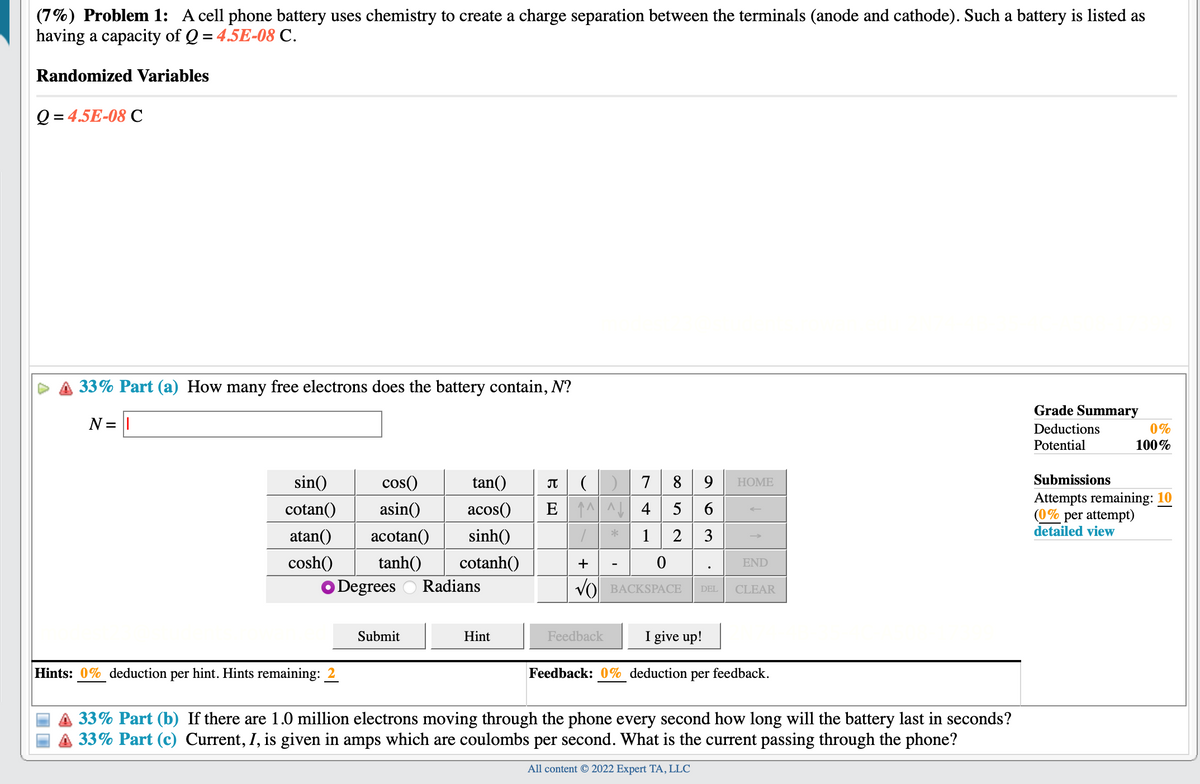(7%) Problem 1: A cell phone battery uses chemistry to create a charge separation between the terminals (anode and cathode). Such a battery is listed as having a capacity of Q = 4.5E-08 C. Randomized Variables Q = 4.5E-08 C A 33% Part (a) How many free electrons does the battery contain, N? Grade Summary Deductions Potential N = 0% 100% sin() cos() tan() 7 8 9 НОМЕ Submissions Attempts remaining: 10 (0% per attempt) detailed view cotan() asin() acos() E AAL 4 6 atan() acotan() sinh() 1 3 cosh() tanh() cotanh() Radians END O Degrees VO BACKSPACE DEL CLEAR Submit Hint Feedback I give up! Hints: 0% deduction per hint. Hints remaining: 2 Feedback: 0% deduction per feedback. O A 33% Part (b) If there are 1.0 million electrons moving through the phone every second how long will the battery last in seconds? A 33% Part (c) Current, I, is given in amps which are coulombs per second. What is the current passing through the phone? All content © 2022 Expert TA, LLC
(7%) Problem 1: A cell phone battery uses chemistry to create a charge separation between the terminals (anode and cathode). Such a battery is listed as having a capacity of Q = 4.5E-08 C. Randomized Variables Q = 4.5E-08 C A 33% Part (a) How many free electrons does the battery contain, N? Grade Summary Deductions Potential N = 0% 100% sin() cos() tan() 7 8 9 НОМЕ Submissions Attempts remaining: 10 (0% per attempt) detailed view cotan() asin() acos() E AAL 4 6 atan() acotan() sinh() 1 3 cosh() tanh() cotanh() Radians END O Degrees VO BACKSPACE DEL CLEAR Submit Hint Feedback I give up! Hints: 0% deduction per hint. Hints remaining: 2 Feedback: 0% deduction per feedback. O A 33% Part (b) If there are 1.0 million electrons moving through the phone every second how long will the battery last in seconds? A 33% Part (c) Current, I, is given in amps which are coulombs per second. What is the current passing through the phone? All content © 2022 Expert TA, LLC
Chapter7: Electric Potential
Section: Chapter Questions
Problem 75P: The probability of fusion occurring is greatly enhanced when appropriate nuclei are brought close...
Related questions
Question
100%
Please help me answer question 1 , Part A,B and C it would be greatly appreciated ,
Thank you in advance
Image is attached

Transcribed Image Text:(7%) Problem 1: A cell phone battery uses chemistry to create a charge separation between the terminals (anode and cathode). Such a battery is listed as
having a capacity of Q = 4.5E-08 C.
%3D
Randomized Variables
Q = 4.5E-08 C
33% Part (a) How many free electrons does the battery contain, N?
Grade Summary
N = ||
Deductions
0%
Potential
100%
8 9
sin()
cos()
tan()
JT
7
НOME
Submissions
Attempts remaining: 10
(0% per attempt)
detailed view
cotan()
asin()
acos()
E 1^
4
5
atan()
acotan()
sinh()
1
2
3
cosh()
tanh()
cotanh()
+
END
O Degrees O Radians
VO BACKSPACE
DEL
CLEAR
Submit
Hint
Feedback
I give up!
Hints: 0% deduction per hint. Hints remaining: 2
Feedback: 0% deduction per feedback.
A 33% Part (b) If there are 1.0 million electrons moving through the phone every second how long will the battery last in seconds?
33% Part (c) Current, I, is given in amps which are coulombs per second. What is the current passing through the phone?
All content © 2022 Expert TA, LLC
Expert Solution
This question has been solved!
Explore an expertly crafted, step-by-step solution for a thorough understanding of key concepts.
This is a popular solution!
Trending now
This is a popular solution!
Step by step
Solved in 3 steps with 3 images

Knowledge Booster
Learn more about
Need a deep-dive on the concept behind this application? Look no further. Learn more about this topic, physics and related others by exploring similar questions and additional content below.Recommended textbooks for you


University Physics Volume 3
Physics
ISBN:
9781938168185
Author:
William Moebs, Jeff Sanny
Publisher:
OpenStax

Modern Physics
Physics
ISBN:
9781111794378
Author:
Raymond A. Serway, Clement J. Moses, Curt A. Moyer
Publisher:
Cengage Learning


University Physics Volume 3
Physics
ISBN:
9781938168185
Author:
William Moebs, Jeff Sanny
Publisher:
OpenStax

Modern Physics
Physics
ISBN:
9781111794378
Author:
Raymond A. Serway, Clement J. Moses, Curt A. Moyer
Publisher:
Cengage Learning